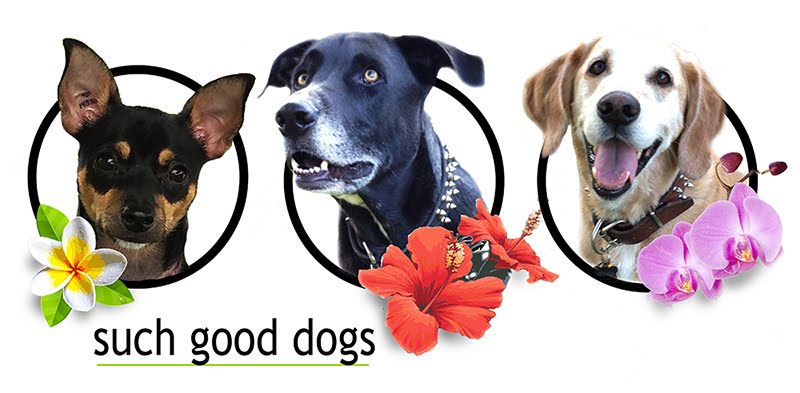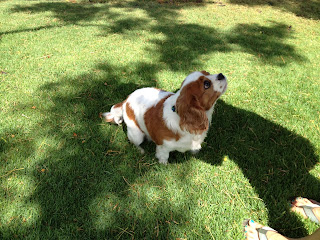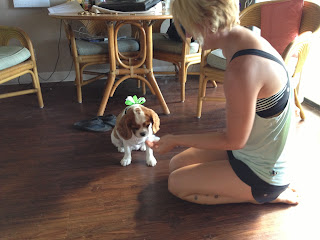Dog Parks...Friend or Foe?
As a dog trainer, people often ask me many questions about training and different dog situations. One that often gets asked is how I feel about dog parks. In response to this question, I'm writing this month's Trainer Tips about dog parks.
If you're a fan of this blog, you know I often write about socialization and how important it is to properly socialize your dog. Proper socialization does include introducing your dog to as many new situations, new people, and new dogs as possible. However, all of these things should be done in a proper environment and at the dog's pace (see previous post). Let me be perfectly clear, it is your job to be the leader in your home and elsewhere. That means it is YOUR job to protect your dog from potentially dangerous situations and YOUR job to keep your dog from being the one that creates any such situation. (See previous post on Leadership.) Keep watch of other dogs and notice their Body Language to gage potential threats.
So how do dog parks fit in?
Generally speaking, I do NOT recommend taking your dog to a dog park on a regular basis. The reason I say this is because dog parks are very chaotic environments with little or no rules. Most people who bring their dogs to the park on a regular basis make the dog park the only regular exercise their dog gets, and generally have little to no control over their pet. This is very bad! A dog should actually be exercised BEFORE being taken to a dog park. Why? Well because when a dog is full of energy and excitement, they are more likely to engage in bad behaviors, especially if they are simply set free to do whatever they want in an chaotic environment with unstable dogs. A huge part of my training program focuses on what I call Energy Balance. If you have ever been to a dog park, you know that the energy and atmosphere of the park is chaotic and crazy. This is NOT an environment I recommend. Because the environment of the dog park is so chaotic, dogs can and will easily pick up bad behaviors. Further more, many dog owners that take their dogs to the dog park should NOT be around other dogs.
FOE!
There is an unofficial dog park in Honokowai that many people go to (including several friends and clients of mine). I have also been to this dog park with my two dogs on a few occasions to check it out. I DO NOT RECOMMEND THIS DOG PARK! This dog park has had several instances of red flag warnings. There is an owner that takes her dog to this park on a regular basis that should never be there. Her dog has attacked at least two dogs that I know of, and bitten at least one owner when going for a third dog. This owner picked up her little dog to get it away from the oncoming attack and the dog attacking jumped up and bit the woman's arm instead. This woman had to have several stitches. This same dog (who is not a very large dog) tried going after one of my dogs as well, Caravaggio. Lucky for me, my dogs are both trained very well and will not engage in a fight unless absolutely necessary. So this little attack dog kept lunging at Caravaggio for at least an hour one day. Caravaggio did exactly what he was taught and moved away from the dog when it tried to attack and let me deal with the situation. Funny enough I left the park with my two dogs for about 15 minutes and returned. Upon our return this same dog came running and jumped up on my car trying to get at the dogs through the window. Ridiculous! The owner, of course, had no control.
This is just one example of a bad apple at the dog park.
Dora getting trampled at the Honokowai dog park.
There is also a high likelihood that your dog will pick up bad habits at a dog park. Some examples of common bad behaviors dogs easily pick up at the dog park include: barking, digging, toy possession, aggression, and not listening to the owner. My best client and the dog I'm most proud of training is named Dora. She is now about a year and a half. I have been training with her and her owner since she was about 5 months old. Dora and her owner made amazing progress and she has turned out to be a great dog. However, about 6 months ago, her owner started taking her to the dog park mentioned above. Since then Dora has picked up several bad habits that we must now address and train her out of. She was also recently attacked (2 weeks ago), and received several puncture wounds on her back foot.
Here's a good example of a dog that should not be at the dog park.
As you can see, the owner has no control.
My other dog, Nekita, was also attacked at a dog park a few years back. She was so severally attacked and injured at the time, that she became dog aggressive for a short while after the attack. We had to put in some extra time and training to get her back to her usual self.
Another little-known danger is poison. There have been various news reports over the last several years about people who do not like dogs leaving poison or toys laced with poison at dog parks. I recently saw a story like this where a dog picked up a toy left at the dog park that someone had poisoned and passed away only an hour later. People leave all kinds of toys at dog parks and most dogs will go up to a toy and pick it up without hesitation. Although this danger is less likely to happen than others, it is still a possibility.
I do not share these things to scare you, but to make you realize just what you may be getting yourself into when attending a dog park. This is not to say that all dog parks are bad all the time. In fact I do believe that a dog park CAN be a fun place for you to socialize your dog. The thing is, you have to really be aware of what's going on around you. Don't become the owner that just brings your dog to the park every day and lets them do whatever they want! If you are interested in attending a dog park, do your homework. Go there without your dog once first at the busiest time (usually in the afternoon after work), and see what the environment is really like. If you don't like what you see, don't return with your dog. You can also try going to the dog park at less popular times. At these times, the dog park will not only be safer for both you and your dog, but more conducive to training and socialization for your dog.
TRY A LESS BUSY TIME
Try the dog park when there is only one or two other dogs around. This environment is much less hectic and better for your dog. This will also allow you to easily assess the situation and meet other dogs and owners. (Below: Wicket & mom playing at the dog park at a quiet time.
FRIEND.
Overall, if you do end up taking your dog to a dog park, please be aware of what is going on around you. Watch your dog at all times and keep them away from any potentially harmful dogs or situations. Also beware of toys. MANY dogs are possessive over toys, especially around large amounts of other dogs. Two dogs going after the same toy can easily trigger a bad situation if one or both dogs are not properly trained and socialized. The time Nekita got attacked in a dog park was because another dog wanted her ball. When she got to the ball first, the other dog attacked her. I have seen this same thing happen multiple times at the dog park. Even if you don't bring your dog's toys, there is always someone who does.
The last reason I do not recommend dog parks is the lazy factor. In my experience, most people who regularly bring their dogs to the dog park do so because they refuse to put any energy into exercising their dogs. The best exercise for a dog is proper walk or hike. And when I say proper, I mean walking on a leash properly, not pulling the owner everywhere. The owner should be in charge of the walk or hike, NOT the dog. A proper walk is the best exercise because the dog is not only getting the physical exercise they require, but mental activity as well. A good owner will properly physically AND mentally exercise their dog. Most people who bring their dogs to the dog park every day have not put in the time and effort to train their dogs on how to walk on a leash, and therefore take the lazy way out...the dog park.
TRY ANOTHER ACTIVITY!
There are so many activities we can do with our dogs, that I don't even need to take my dogs to such a place. Go for a walk, go for a hike, go swimming, play fetch. There are so many other forms of activities that are much healthier for both you and your dog. So stop being the lazy owner that does nothing with your dog and get out on a new adventure! You're dog will thank you!
Plus, its fun and even easier to make friends with other dogs at these activities!
Caravaggio, Dora, & Nekita swimming.
Kana & Nekita relaxing on the beach.
Kahiko & Dora hanging out after a hike.
Caravaggio & Jack at the beach playing fetch.
TAKE A TRAINING CLASS
Still need a way to make some new doggie friends? A great way to meet new dogs and new owners is to take a dog training class or activity. In every class I have taught, at lease someone makes a new friend that they keep in contact with even after the class is over. Such Good Dogs also offers socialization hours, where you and your dog can meet new dogs that are properly trained in a healthy environment.
Kuma watching Mocha & Kengie say hello
in their first Basic Manners Class.
Splash & Eku became fast friends.
Budi'i & Henry playing after our class.




































